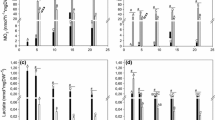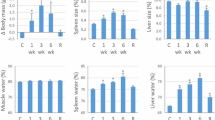Abstract
Growth and glycogen content of Chironomus anthracinus in Lake Esrom, Denmark was examined during summer stratification in 1992 and 1993. Simultaneously, effects of oxygen deficiency on glycogen utilization and survival were experimentally studied. The population consisted of almost fullgrown 4th instar larvae in 1992 and 2nd and 3rd instar larvae in 1993. Growth rate and glycogen content changed as hypolimnetic oxygen deficiency increased. During a 1st phase of stratification dry weight and glycogen content increased (2nd and 3rd instars) or was almost constant (4th instar) but decreased significantly during the following 2nd phase. This change from growth to degrowth and utilization of endogenous glycogen reserves correlated with a change in the thickness of the microxic layer (<0.2 mg O2 1−1) above the sediment surface. The layer increased from 2–3 m in phase 1 to 4–5 m in phase 2, and we suggest that this deteriorated the oxygen conditions and resulted in a change in larval energy metabolism from fully aerobic during the 1st phase to partly anaerobic in the 2nd phase. During the 2nd phase larval metabolism was estimated at less than 20% of normoxic rate. Experimental exposure of the larvae to anoxia indicated highly different survival of young larvae (2nd and 3rd instars) and older larvae (large 4th instars). The morality of young larvae was 50% after three days in anoxia at 10 °C, whereas only 25% of the older larvae had died after 3–4 weeks under similar conditions. Extending the treatment, however, resulted in increased death rate of the 4th instar larvae with only 10% surviving after seven weeks. The anaerobic metabolism of 4th instar larvae as estimated from glycogen degradation at 10 °C was 5% of normoxia in the interval from 0–5 days but 1.5% in the interval from 20–25 days. It is concluded that survival of C. anthracinus in anoxia is very limited, but traces of oxygen in the environment allowing for faint aerobic metabolism prolong the survival time of the larvae from a few days (2nd and 3rd instars) or a few weeks (4th instar) to probably 3–4 months.
Similar content being viewed by others
References
Allanson, B. R., 1990. Physical processes and their biological impact. Verh. int. Ver. Limnol. 24: 112–116.
Augenfeld, J. M., 1967. Effects of oxygen deprivation on aquatic midge larvae under natural and laboratory conditions. Physiol. Zool. 40: 149–158.
Bairlein, F., 1989. The respiration of Chironomus-larvae (Diptera) from deep and shallow waters under environmental hypoxia and at different temperatures. Arch. Hydrobiol. 115: 523–536.
Berg, K., 1938. Studies on the bottom animals of Esrom Lake. K. Danske Vidensk. Selsk. Skr. Naturv. Math. Afd. 9. Rk 8: 1–225.
Berg, K., P. M. Jónasson & K. W. Ockelmann, 1962. The respiration of some animals from the profundal zone of a lake. Hydrobiologia 19: 1–39.
Berg, K. & P. M. Jónasson, 1965. Oxygen consumption of profundal lake animals at low oxygen content of the water. Hydrobiologia 26: 131–143.
Brundin, L., 1949. Chironomiden und andere Bodentiere der südschwedischen Urgebirgsseen. Ein Beitrag zur Kenntnis der bodenfaunistischen Charakterzüge schwedischer oligotropher Seen. Rep. Inst. Freshwat. Res. Drottningholm 30: 1–914.
Famme, P. & J. Knudsen, 1984. Total heat balance study of anaerobiosis in Tubifex tubifex (Müller). J. Comp. Physiol. B 154: 587–591.
Frank, C., 1983. Ecology, production and anaerobic metabolism of Chironomus plumosus L. larvae in a shallow lake. II. Anaerobic metabolism. Arch. Hydrobiol. 96: 354–362.
Gomme, J., 1982. Epidermal nutrient absorption in marine invertebrates: A comparative analysis. Am. Zool. 22: 691–708.
Gnaiger, E., 1991. Animal energetics at very low oxygen: information from calorimetry and respirometry. In R. Woakes, M. Grieshaber & C. R. Grieshaber (eds), Strategies for Gas Exchange and Metabolism. Soc. Exp. Biol. Seminar Ser. 44, Cambridge Univ. Press, London: 149–171.
Gordon, M. S., 1972. Animal Physiology: Principles and Adaptations. Macmillan Publishing Co., Inc. New York, 591 pp.
Hamburger, K., P. C. Dall & P. M. Jónasson, 1990. The role of Dreissena polymorpha Pallas (Mollusca) in the energy budget of Lake Esrom, Denmark. Verh. int. Ver. Limnol. 24: 621–625.
Hamburger, K., P. C. Dall & C. Lindegaard, 1994. Energy metabolism of Chironomus anthracinus (Diptera, Chironomidae) from the profundal zone of Lake Esrom, Denmark, as a function of body size, temperature and oxygen concentration. Hydrobiologia 294: 43–50.
Hand, S. C., 1991. Metabolic dormancy in aquatic invertebrates. Adv. Comp. Envir. Physiol. 8: 1–49.
Heinis, F. & T. Crommentuijn, 1992. Behavioral responses to changing oxygen concentrations of deposit feeding chironomid larvae (Diptera) of littoral and profundal habitats. Arch. Hydrobiol. 124: 173–185.
Hipp, E., U. Bickel, T. Mustafa & K. H. Hoffmann, 1986. Integumentary uptake of acetate and propionate (VFA) by Tubifex sp., a freshwater oligochaeta. II. Role of VFA as nutritional resources and effects of anaerobiosis. J. exp. Zool. 240: 299–308.
Hofmann, W., 1971. Die postglaziale Entwicklung der Chironomiden- und Chaoborus-Fauna (Dipt.) des Schöhsees. Arch. Hydrobiol. Suppl. 40: 1–74.
Kiørboe, K., F. Møhlenberg & K. Hamburger, 1985. Bioenergetics of the planktonic copepod Acartia tonsa: relation between feeding, egg production and respiration, and composition of specific dynamic action. Mar. Ecol. Prog. Ser. 26: 85–97.
Jónasson, P. M., 1972. Ecology and production of the profundal benthos in relation to phytoplankton production in Lake Esrom. Oikos Suppl. 14: 1–148.
Jónasson, P. M., 1978. Zoobenthos of lakes. Verh. int. Ver. Limnol. 20: 13–37.
Jónasson, P. M., 1984. Decline of zoobenthos through five decades of eutrophication in Lake Esrom. Verh. int. Ver. Limnol. 22: 800–804.
Lundbeck, J., 1926. Die Bodentierwelt norddeutscher Seen. -Arch. Hydrobiol. Suppl. 7: 1–143.
Lindegaard, C., P. C. Dall & S. B. Hansen, 1993. Natural and imposed variability in the profundal fauna of Lake Esrom, Denmark. Verh. int. Ver. Limnol. 25: 576–581.
Nagell, B. & C-C. Landahl, 1978. Resistance to anoxia of Chironomus plumosus and Chironomus anthracinus (Diptera) larvae. Holarct. Ecol. 333–336.
Tátrai, I., 1982. Oxygen consumption and ammonia excretion of herbivorous chironomid larvae in Lake Balaton. Hydrobiologia 96: 129–135.
Thienemann, A., 1954. Chironomus. Leben, Verbreitung und wirtschaftliche Bedeutung der Chironomiden. Die Binnengewässer 20: 1–834.
Thomas, J. D., P. R. Sterry & R. L. Patience, 1984. Uptake and assimilation of short chain carboxylic acids by Biomphalaria glabrata (Say), the freshwater pulmonate snail host of Schistosoma mansoni (Sambon). Proc. r. Soc. Lond. B. 222: 447–476.
Wilps, H. & E. Zebe, 1976. The end-products of anaerobic carbohydrate metabolism in the larvae of Chironomus thummi. J. comp. Physiol. 112: 263–272.
Author information
Authors and Affiliations
Rights and permissions
About this article
Cite this article
Hamburger, K., Dall, P.C. & Lindegaard, C. Effects of oxygen deficiency on survival and glycogen content of Chironomus anthracinus (Diptera, Chironomidae) under laboratory and field conditions. Hydrobiologia 297, 187–200 (1995). https://doi.org/10.1007/BF00019284
Received:
Revised:
Accepted:
Issue Date:
DOI: https://doi.org/10.1007/BF00019284




